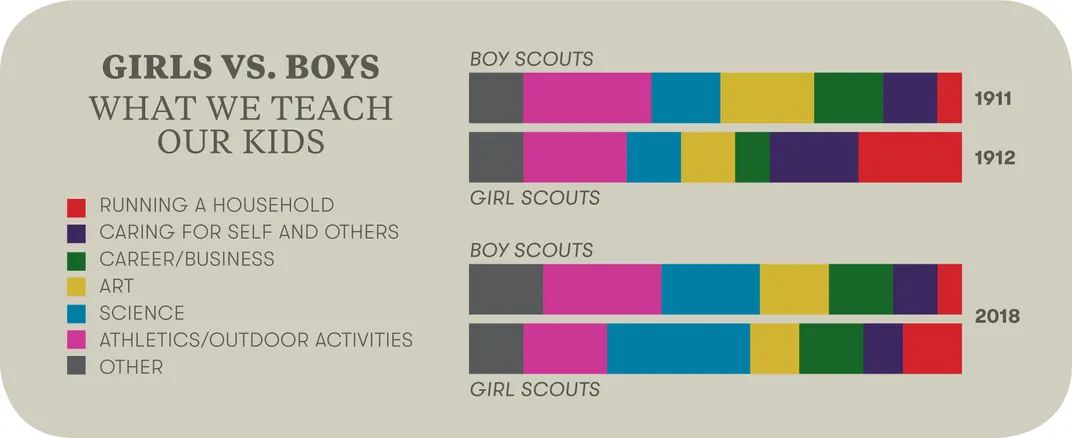How the History of Merit Badges Is Also a Cultural History of the United States
Over the years, scouting has encouraged boys and girls to be prepared for the world around them
/https://tf-cmsv2-smithsonianmag-media.s3.amazonaws.com/filer/b0/df/b0dfa68b-07f1-4d79-a7a5-8b9b240616a2/badges-resize.jpg)
At first glance, there’s something undeniably old fashioned about the Girl Scouts and the Boy Scouts. The organizations have legacies that stretch back more than a hundred years to the days when boys were taught to tramp through the woods and girls were taught to keep a tidy home. Today some 4 million kids still wear those iconic cloth sashes dotted with merit badges—a tradition first introduced by the Boy Scouts in 1911 and the Girl Scouts in 1912.
But if you look more closely at each embroidered round, you’ll discover that the scouts have been anything but static over the last century. The ever-changing roster of Girl Scout and Boy Scout merit badges forms an accidental history of American childhood, a record of what it has meant for girls and boys to “be prepared”—the eternal scouting motto—through two world wars, the Cold War and the War on Terror, through the birth of television, the dawn of the Space Age and the arrival of the internet. Often these boys and girls were our advance scouts: Boys earned a merit badge in automobiling in 1911, when barely one percent of the population owned a car. Girls earned one in Civics in preparation for the vote; it was renamed the Citizen badge with the ratification of the 19th amendment in 1920.

Now, as the Boy Scouts enroll the first girls in their ranks, and the Girl Scouts introduce two dozen new STEM badges, outpacing the boys in science education, a look back at what we’ve taught our kids, from the Greatest Generation to the next one.
Automobiling, 1911
/https://tf-cmsv2-smithsonianmag-media.s3.amazonaws.com/filer/2f/65/2f65e62b-3be1-4941-83b9-5f7149a23d93/badges1.png)
Less than 1 percent of the U.S. population owned a car when the Boy Scouts first learned to drive.
Citizen, 1920
/https://tf-cmsv2-smithsonianmag-media.s3.amazonaws.com/filer/26/26/262687bb-b8c3-4bd4-97e6-00ff33939874/badges2.png)
After the passage of the 19th Amendment, the Girl Scouts’ Civics badge became the Citizen badge.
Business Woman, 1920
/https://tf-cmsv2-smithsonianmag-media.s3.amazonaws.com/filer/b4/e5/b4e56c5e-6b76-4402-b0c1-d20300d61ea7/badges3.png)
As more women entered the workforce after World War I, Girl Scouts learned clerical skills.
World Knowledge, 1931
/https://tf-cmsv2-smithsonianmag-media.s3.amazonaws.com/filer/f1/b1/f1b1e066-6c7f-4f5a-80e8-f9c1560de035/badges4.png)
Between the world wars, the Girl Scouts began fostering friendships around the globe.
Airplane Design, 1942
/https://tf-cmsv2-smithsonianmag-media.s3.amazonaws.com/filer/d4/65/d4656482-0451-44ef-a425-a0c1f416bfe6/badges5.png)
During the war, the Boy Scouts went all in on aviation, even introducing the spinoff Air Scouts.
Radio & Television, 1953
/https://tf-cmsv2-smithsonianmag-media.s3.amazonaws.com/filer/7b/97/7b974a9a-0345-417f-8f58-1fa70a92908e/badges6.png)
The Radio badge, debuted in 1938, was updated as TV began vying for media dominance.
Atomic Energy, 1963
/https://tf-cmsv2-smithsonianmag-media.s3.amazonaws.com/filer/13/4f/134ff9a9-3d2c-4012-889d-21122cfe45d5/badges7.png)
Scouts were taught the science of the nuclear threat—as interest in nuclear power grew through the decade.
American Heritage, 1975
/https://tf-cmsv2-smithsonianmag-media.s3.amazonaws.com/filer/b8/2c/b82ce565-b2f3-4a38-bd73-925f24eb8f69/badges8.png)
In advance of the country's bicentennial, the scouts resolved to teach boys about U.S. history.
Handicap Awareness, 1985
/https://tf-cmsv2-smithsonianmag-media.s3.amazonaws.com/filer/d1/96/d1967d5a-60db-4bc1-8aa9-f6d5e34a1f4e/badges9.png)
The scouts were ahead of the curve here; the Americans with Disabilities Act passed in 1990.
Crime Prevention, 1996
/https://tf-cmsv2-smithsonianmag-media.s3.amazonaws.com/filer/5a/dc/5adc86d4-d74d-41aa-9dae-9fb59e3a8ea2/badges10.png)
Crime decreased dramatically in the 1990s, but concern about crime was on the rise when this badge launched.
Oil Up, 2001
/https://tf-cmsv2-smithsonianmag-media.s3.amazonaws.com/filer/f3/8b/f38b8fb0-e60f-48de-a0c4-9bc41e2c44e4/badges11.png)
U.S. oil usage peaked in the 2000s, but this badge was more ecology-minded than its design.
Space Science Investigator, 2018
/https://tf-cmsv2-smithsonianmag-media.s3.amazonaws.com/filer/db/15/db15ec6c-0016-4bd8-a7f2-4c73680507ff/badges12.png)
One of 24 new STEM badges offered by the Girl Scouts—on topics from cybersecurity to robotics.